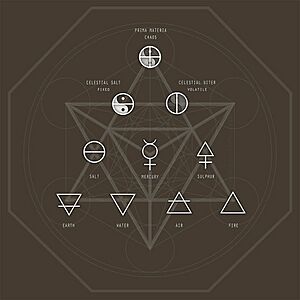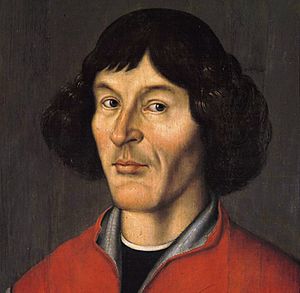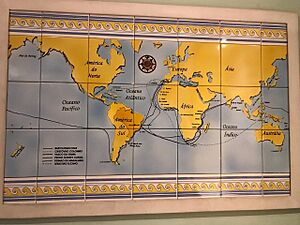Science in the Renaissance facts for kids
The Renaissance was a time of huge changes in Europe, from around the 14th to the 17th century. During this period, people made amazing progress in many areas of science. Think about geography, astronomy, chemistry, physics, mathematics, anatomy, and engineering!
One big reason for this progress was the rediscovery of old scientific books. People started collecting these ancient texts in the early 1400s. This continued until 1453, when the city of Constantinople fell. Also, the invention of printing meant new ideas could spread much faster than ever before.
Some historians used to think the early Renaissance actually slowed down science. They felt that people focused more on human subjects like history and politics, rather than science. But more recently, experts agree that the Renaissance helped science a lot. They point to finding lost books and a new focus on understanding old writings correctly.
A historian named Marie Boas Hall called the early part of this time the Scientific Renaissance. This period, from 1450 to 1630, was the start of the bigger Scientific Revolution. Another expert, Peter Dear, suggests two phases. The first was the "Scientific Renaissance" (15th and 16th centuries). It was about bringing back ancient knowledge. The second was the "Scientific Revolution" (17th century), when scientists started creating totally new ideas.
Contents
A Difficult Time Before the Renaissance
Before the Renaissance, Europe had a time of great learning, especially about nature. But in the 14th century, a series of tough events happened. This time is known as the Crisis of the Late Middle Ages.
The worst event was the Black Death. This terrible plague killed a huge number of people, about 25% to 50% of Europe's population. It hit towns the hardest, which were places where new ideas and inventions often started. The plague stopped a lot of scientific progress. The population kept dropping for another century because the plague kept coming back.
The Renaissance Begins
The 14th century marked the start of the Renaissance, a major cultural movement. By the early 1400s, people were actively searching for old handwritten books across Europe. This search continued until 1453. When Constantinople fell, many Greek scholars moved to the West, especially Italy, bringing their valuable books with them.
The invention of the printing press also changed everything. It made books much easier to get. This helped more people learn and allowed new ideas to spread quickly.
At first, there weren't many new discoveries in physics or astronomy. People greatly respected old thinkers like Aristotle and Ptolemy. Their ideas about the universe were still very strong. Later, when no more old books could be found, scholars started editing and translating the ones they had. This led to new scientific work by people like Copernicus, Cardano, and Vesalius.
Important Discoveries
Alchemy and Chemistry
During the Renaissance, alchemy and chemistry were often linked. They were sometimes called "chymistry." Alchemy was about changing materials through secret processes. Alchemists wanted to turn common metals into gold. They believed there was a basic substance from which everything else was made. If you could get back to this original material, you could then make it into something new, like lead into gold. Medieval alchemists often worked with "sulphur" and "mercury" as key elements.
Paracelsus was a famous chymist and doctor during this time. He believed that "salt" was also a main element, along with sulphur and mercury. Paracelsus was important because he used chemical practices for medicine. He thought the human body worked through chemical processes. His ideas went against many old beliefs, like those from Aristotle. But Paracelsus insisted that questioning nature was key to gaining new knowledge.
Even though chymistry used scientific methods, it wasn't seen as a proper academic subject for a long time. It was more like a craft or business. It only started to appear in university studies near the end of the Renaissance.
Astronomy

In the late Middle Ages, people believed the Earth was the center of the universe. This idea came from Claudius Ptolemy in ancient times. Most astronomers didn't read Ptolemy's main book, the Almagest. Instead, they used simpler textbooks like De sphaera mundi by Johannes de Sacrobosco. For predicting planet movements, they used tables based on Ptolemy's ideas.
Around 1450, a mathematician named Georg Purbach started teaching astronomy. His student, Regiomontanus, published Purbach's notes as Theoricae novae planetarum. This new textbook became very popular. Purbach also started writing a summary of Ptolemy's Almagest. After he died, Regiomontanus finished it. This book, published in 1496, made Ptolemy's advanced astronomy available to many European astronomers.
The most famous event in Renaissance astronomy was the work of Nicolaus Copernicus (1473–1543). He was one of the first astronomers to learn from the new textbooks. Around 1514, he started thinking about an old idea: that the Earth revolves around the Sun. He spent the rest of his life trying to prove this idea mathematically. His book, De revolutionibus orbium coelestium, was published in 1543, just as he was dying. Copernicus followed Ptolemy's methods in many ways. So, he was a Renaissance scientist, not a complete revolutionary.
It wasn't until Johannes Kepler (1571–1630) and Galileo Galilei (1564–1642) that Ptolemy's way of doing astronomy was truly changed. Better math and tables led to the creation of the Gregorian calendar in 1582. This new calendar fixed errors in the old one, especially for calculating the date of Easter.
Mathematics
The amazing work of ancient Greek mathematicians survived through many centuries. Books by Euclid, Archimedes, and Apollonius were copied and studied in both the Byzantine Empire and Islamic learning centers. Translators started turning these works into Latin in the 12th century. Two important translators were Gerard of Cremona and William of Moerbeke.
The biggest translation effort happened in Italy during the 15th and 16th centuries. Almost all leading mathematicians wanted to bring back the ancient Greek math books. Scholars who studied human subjects helped mathematicians find these old Greek writings. They also translated them into Latin, often with support from religious leaders.
Key figures in this effort included Regiomontanus, who copied Archimedes' Latin works and planned to print math books. Federico Commandino (1509–1575) also published editions of Archimedes, Euclid, and others. Francesco Maurolico (1494–1575) not only translated ancient math but also added his own new ideas. Their translations made sure that the next generation of mathematicians had much more advanced techniques than those available in the Middle Ages.
However, math in the 15th and 16th centuries wasn't just about old Greek works. Some mathematicians, like Tartaglia and Luca Paccioli, built on the math traditions from Islamic scholars and medieval thinkers.
Physics
As math improved, so did physics. Scientists like Galileo tried to connect these two fields. They also started questioning old ideas from Aristotle. This new look at physics opened up many opportunities in areas like mechanics, optics, navigation, and map-making.
Ideas about mechanics (how things move) came from the ancient Greeks, especially Aristotle and Archimedes. In ancient Greece, mechanics and philosophy were closely related. It was only during the Renaissance that these two subjects began to separate. Many new ideas in mechanics came from Italians like Rafael Bombelli, and also from Simon Stevin in Flanders. Galileo also helped this field with a book on mechanics in 1593. He developed ideas about how things fall freely and move in a straight line.
Navigation was very important during this time. Many new inventions, along with better ships and the compass, led to great geographical discoveries. Calculating positions at sea was hard. The technology couldn't accurately predict weather or find a ship's exact location. Finding longitude (east-west position) was especially difficult. Sailors had to rely on "dead reckoning," which meant guessing their position based on speed and direction. This method had many uncertainties.
Medicine
The Renaissance brought more experiments, especially in studying the human body through dissection. This greatly improved our knowledge of human anatomy. Modern neurology (the study of the nervous system) began in the 16th century with Andreas Vesalius. He described the brain and other organs. However, he didn't know much about how the brain actually worked.
Understanding medical science and how to diagnose illnesses got better. But there wasn't much direct help for patients. Few effective medicines existed. William Harvey later gave a detailed description of how blood moves through the body in the circulatory system. The most useful medical books for students and doctors were those listing medicines and their uses.
Geography and the New World
In the history of geography, an important old book was Geographia by Claudius Ptolemy (from the 2nd century). It was translated into Latin in the 15th century. Many people read it, and it was printed many times after 1475. Ptolemy's Geographia became the basis for most maps made in Europe during the 15th century.
Ptolemy's system, which used coordinates and projections, helped make cartography (map-making) a scientific field, not just an art. However, the information from Ptolemy and other old sources soon didn't match the new lands being explored. The Age of Discovery showed that ancient knowledge had its limits. It also opened up new possibilities for Europeans.
For example, Christopher Columbus's trip to the New World in 1492 started a wave of European exploration. Early maps often greatly underestimated how much land separated Europe from Asia if you sailed west. But explorers like Ferdinand Magellan helped create more accurate maps during this period.
See also
 In Spanish: Historia de la ciencia en el Renacimiento para niños
In Spanish: Historia de la ciencia en el Renacimiento para niños
- Continuity thesis
- The Copernican Question
- Renaissance magic
- Renaissance technology





